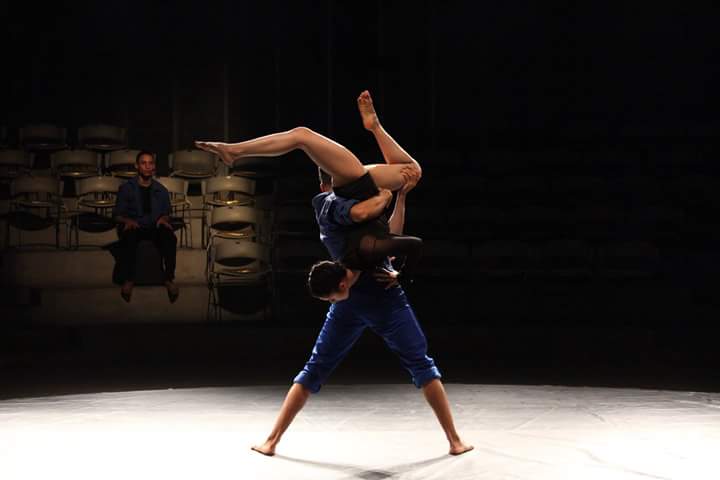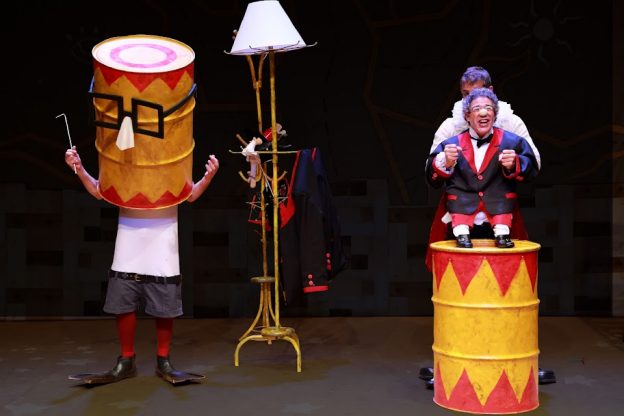Dorothy Max Prior reports on the São Paulo Showcase at the Edinburgh Festival Fringe 2025
Stepladders and big steel bins painted yellow and red that are converted into trolley buses, trains and planes; hats sprouting bananas and flower pots; reversible jackets, big shoes, and prosthetic noses… This is classic clowning of the sort that seems to be done so well by Brazilian companies – and The Mequetrefo (aka The Scoundrel) is a prime example. It is a four-man show presented by leading clown company Parlapatões who are based in central São Paulo and have toured extensively both in Brazil and across the world for the past 30 years.
The Mequetrefo is billed as a show for all the family, but I would view the age guideline of 3+ as optimistic. These clowns are a little scary! Within the first five minutes of the show, at least two pre-schoolers have started sobbing and need to be escorted out from the auditorium – always a sign of a good clown show, in my experience. Meanwhile, the seven-year-olds and their parents are howling with laughter as the four clowns – all called Day – run through their absurd daily routines. It is no coincidence that Beckett wanted Vladmir and Estragon, in Waiting For Godot, to be played by vaudevillian clowns – clowns perfectly mirror our human fears and foibles back to us – but whereas Beckett’s clowns spend all day doing nothing but waiting, this lot don’t get a moment’s rest in their busy day.
To a soundtrack of electro-swing Charlestons and Gypsy Jazz classics – fortified by the sounds of buzzers, bells and sirens – our four Days create a sometimes elegant often anarchic choreography of beatings with rubber mallets, formation dancing in and out of their jackets, taking showers with water pistols, and aping the monkeys in the zoo cage constructed with those ever-versatile stepladders. There is talking, in broken English, that works mostly – although some gags are lost in translation a little, and when the ensemble move into banter in their native Portuguese, the spoken text immediately springs to life. I think they could allow themselves more Portuguese or even Commedia dell’Arte style grammelot, in to the verbal mix.
The visual and physical elements are top-notch. As well as all those breathless transformations of aforementioned stepladders, there’s a fabulous ‘humanette’ puppetry scene; a spooky ‘upside-down face becomes puppet’ moment; and a wonderful rocket launch using a steel can and an umbrella, to the tune of Also Sprach Zarathustra. The sound and lighting design is excellent, and despite the height restrictions of the Underbelly Fresian venue almost cramping their style, the show moves along at a great pace, these seasoned performers never missing a cue.

Over at the beautiful Bijou Spiegeltent, sited outside the Assembly Rooms, Brazilian actor and one-time restaurant owner Eduardo Estrela of Cia La Troupe leads an immersive storytelling show, What’s In The Kitchen, which celebrates the range and regional diversity of Brazilian cuisine. As we are welcomed in to the space, given a ginger-flavoured shot of cachaça and a lunch bag of numbered goodies that we are asked not to open until told, the space fills with the sound of classic Samba and Bossa Nova – ‘Girl from Ipanema’, ‘Mais Que Nada’ and more…
Eduardo is a relaxed and convivial host, drawing parallels between the life of an actor and the life of a restaurant owner: both work when other people have time off; and in both cases, the show must go on, regardless.We learn that the enormous diversity of cuisines in Brazil is down to the influx of migrants – whether that’s the forced migration of the slave trade, bringing African influences to the North East region of Bahia; the enormous São Paulo Japanese community, which is the biggest outside of Japan; or the spread of Italian families throughout the south and south-east of Brazil.
Throughout the piece, Edaurdo alternates between narrator/storyteller mode and character actor. Behind him is an old-fashioned wooden coat rack, and the different characters are brought to life by the donning of a few simple articles of clothing, the transformations taking place quickly and simply, in front of the audience. Thus, we meet TV cook Ricki (silver lurex jacket and extravagant gestures); working-class Bahian chef Genésio (white chef’s jacket and black headcovering, serious demeanour with dedication to the job at hand); and the wonderful Teresa, matriarch of a large Italian-Brazilian family (simple red apron, a heart full of love and lively stories). Each character takes up the baton of an ongoing cooking project: first, a bowl of dough – which prompts Eduardo to marvel at the magical transformation that is undergone when flour is mixed with water and salt. A miracle, no less! TV cook Ricki introduces a couple of famous chefs (little mannequins) who share their experiences and bon mots. Then, the dough is rolled out on to the table and Genésio gives us his life story, from impoverished and hungry orphan, to cooking for a rich family, astonished by how much food they have in their larder; and eventually running a restaurant kitchen. Finally, the dough is cut into tagliatelle ribbons and hung to dry, as Teresa tells us of her joy in cooking for the whole family every Sunday. Meanwhile, each time we return to storyteller Eduardo, a bell is rung (Pavlov’s dogs respond!) and we are allowed to open up another small package of food – for example, item 2 is a little marshmallow and a home-baked savoury cracker, demonstrating the balance between the tastes of sweet and umami.
What’s in the Kitchen joins a noble tradition of Edinburgh Fringe shows based around cooking and eating – see, for example, the 2024 Total Theatre article Soul Food. Eduardo Estrela’s take on it all is a very welcome addition – an interesting speculation on Brazil’s history and culture, as determined by its cuisine; an adventure for the senses provoking much food for thought.

Meanwhile, over at Dance Base, the São José dos Campos Dance Company and internationally renowned choreographer Lili de Grammont present a dance-theatre double bill, Voyeur / Samba and Love. The first piece, as the title might imply, is about ‘the gaze’. As we enter the space, we see five chairs placed in a diagonal line across the black vinyl dancefloor. Each chair is occupied, and as we walk past and take our seats, we feel the eyes watching us. The house lights dim, and two more figures enter the space. There follows a clever play on watching and being watched; performing and witnessing. At times, it all seems benign – rather like a session of Authentic Movement, in which movers are witnessed supportively by non-movers. At other times, it feels more ominous – for example, as the chairs are moved into a circle, and a couple enact a physically strenuous power struggle that (to my mind, anyway, knowing that they are from São Paulo) seems to have echoes of the Baile Funk dancing that sees girls subjected to some pretty aggressive moves. The choreography of the chairs is really lovely – at one point, a chair sits alone centre-stage, illuminated by a single violet light. The piece mixes duets and ensemble work. There’s a great scene set in traverse, with some of the company shining hand-held spotlights onto two dancing couples, creating a four-way medley of beams that the dancers move in and out of, shadows cast on the walls, whilst the sound of a projector ticks over.

Talking of sound: the second piece, Samba & Love, is inspired by Brazilian musical giant, Chico Buarque. The brilliant soundtrack, by film composer Antônio Pinto, best known for his collaborations with British filmmaker Asif Kapadia (on films such as Amy and Diego Maradona) deconstructs Chico Buarque’s samba and bossa nova classics – slowing down, adding in, and mulching with found sounds; here, a bird song, there a cuica or cowbell. The ensemble form a samba roda or circle, with different pairs – male and female, or all-male or all-female – moving in to the centre, capoeira style, to battle out their moves; or in a humorous scene set on an inflatable sofa, they play out a therapy session to a background of the collaged city sounds of horns, sirens and revved motorbikes. Then, there’s a really excellent scene as a couple fight, a table and two chairs their battlefield, the rest of the ensemble ‘puppeteering’ the scene by moving furniture and bodies around the space, a batucada beat building…
Two very different dance-theatre pieces, both excellent – cleverly choreographed and performed with great gusto and enormous skill. A great addition to the São Paulo Showcase programme.
These were the shows that I managed to catch in the first week of the Edinburgh Fringe. There were others that I would have liked to have seen, but couldn’t fit in to the schedule – a full list follows, for anybody interested.
There seemed to be a rich and varied selection of work presented, although I would have liked to see some circus and some experimental live art/performance in the mix – next time, hopefully! And some big São Paulo theatre names were surprisingly missing, most obviously São Paulo-Campinas based legends Lume Teatro, who make work of many types and scales; and it would have been good to see the long-established ParaladosanjoS, whose work spans circus, physical theatre and site-responsive genres, in the programme. But perhaps they’ll come another time – it would be great if this showcase could become a regular fixture at the Edinburgh Festival Fringe. As it is, this year’s programme is a great start to what hopefully will be an ongoing collaboration.

São Paulo Showcase at the Edinburgh Festival Fringe 2025 – full programme
Another Sight by Blind Theater (Teatro Cego) and C3 Cultural Projects 1 – 24 August @ Zoo Playground, 20.45
Cheese and Guava or Romeo and Juliet by Cênica 31 July – 25 August @ Summerhall, 10.35
Honest Fraud by Fundo Falso 30 July – 25 August @ Underbelly, Bristo Square, 16.40
The Mequetrefo by Parlapatões 30 July – 10 August @ Underbelly, Bristo Square, 11.20
Double Bill: Voyeur / Samba and Love by São José dos Campos Dance Company and Lili de Grammont 31 July – 24 August @ Assembly, Dance Base, 13.00
What’s In The Kitchen by Cia La Troupe 31 July – 23 August @ Assembly Rooms, Bijou, 14.10
Supported by São Paulo State Secretariat of Culture, Economy and Creative Industries, in association with InvestSP and Consulado-Geral do Brasil em Edimburgo, and produced by Associação Paulista dos Amigos da Arte.


































